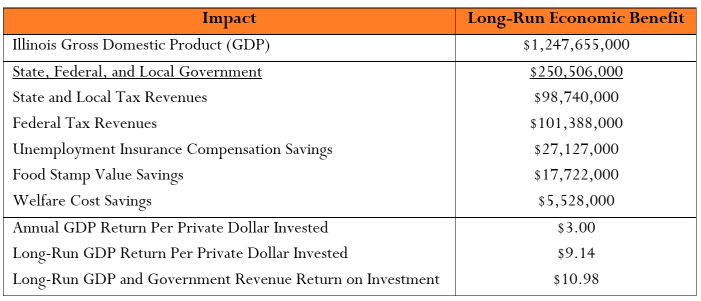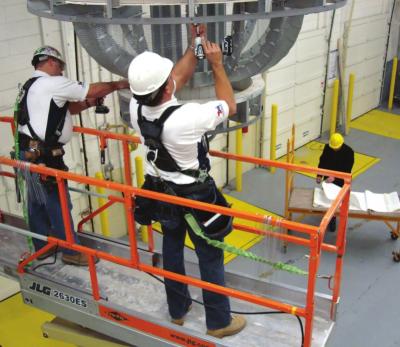A new report from the Illinois Economic Policy Institute and the Project for Middle Class Renewal at the University of Illinois finds that apprenticeship programs have significant positive social and economic impacts in Illinois.
REPORT [PDF]: The Impact of Apprenticeship Programs in Illinois: An Analysis of Economic and Social Effects
Construction is the fastest-growing industry in Illinois. Over the next decade, the construction industry is projected to grow at twice the pace of the overall state economy, adding thousands of new jobs. All of the fastest-growing trades in Illinois’s construction industry require at least 3 years of apprenticeship training.
For many young Illinois workers, enrolling in a registered apprenticeship program is a better option than attending college or university. The annual income gain from participating in a registered apprenticeship program is $3,442 on average, greater than the average effect of having an associate’s degree and many bachelor’s degrees– including social work, English language and composition, and linguistics and foreign languages.

If all registered apprenticeship programs for construction were combined, they would be the 7th-largest private post-secondary educational institution in Illinois. In Fiscal Year 2015, there were 10,811 participants in registered construction apprenticeship programs, which is over 3,000 more students than Roosevelt University.
Cumulatively, construction apprenticeship programs invested over $136 million in worker skills upgrading and development. The average out-of-pocket expenditure for apprentices amounts to $4,056 over four years, compared to average student debt repayments totaling over $36,000 for Illinois residents graduating from a 4-year university.
Joint labor-management apprenticeship programs account for the vast majority of human capital investment in Illinois’ construction industry. Fully 98.5 percent of all construction apprentices are enrolled in joint programs by union contractors. Joint labor-management apprenticeship programs also comprise 99.2 percent of all privately-funded apprenticeship expenditures in Illinois.

Joint labor-management programs in construction differ from their nonunion counterparts in many significant ways:
- Average program expenditures per apprentice are $12,715 in joint labor-management programs and only $6,585 in nonunion programs;
- Joint labor-management programs average 3.7 registered apprentices per program employee while nonunion programs have 14.7 apprentices per program employee;
- The share of women and people of color is 30.8% in joint labor-management programs but just 27.9% in nonunion programs.
Registered apprenticeship programs in Illinois’ construction industry generate substantial economic benefits to the state. Every year, the programs directly provide nearly 2,900 jobs for instructors and other employees. Through program expenditures and the net on-the-job earnings of participants, registered apprenticeship programs save or create nearly 5,000 total jobs in Illinois and annually boost the state’s economy by over $400 million. Registered apprenticeship programs in construction also increase state and local tax revenues by almost $30 million every year.
The programs have even larger impacts over the long run. Registered apprenticeship programs in Illinois’ construction industry provide $1.25 billion in long-term economic benefits to the state. Over the careers of program participants, state and local government tax revenue increases by $100 million, and government assistance falls by millions of dollars. Over 36 years, the total economic and social return on investment from construction apprenticeship programs is $11 per dollar invested in worker training.

The economic benefits of registered apprenticeships should be expanded into many sectors other than construction. The United States Department of Labor lists 1,060 “apprenticeable occupations,” of which only 121 are in construction. From fast-growing occupations such as home health aides, nurse assistants, and computer programmers to traditional occupations like truck drivers, machinists, and corrections officers, there is substantial opportunity and an increasing need for apprenticeship programs to improve worker productivity, support the middle class, and grow the economy.
The State of Illinois can enact six potential public policies to promote registered apprenticeship programs. The State of Illinois should:
- Improve marketing and outreach to businesses and disadvantaged workers;
- Expand access to child care programs to boost female participation;
- Provide tax credits to businesses that offer apprenticeship programs;
- Expand pre-apprenticeship programs in public high schools and support comprehensive trades programs such as the innovative new initiative at Dunbar Vocational High School on the south side of Chicago;
- Encourage public universities to develop degree completion programs for eligible apprentices by awarding college credits for classroom hours earned during apprenticeship programs; and
- Support policies that increase unionization and strengthen prevailing wage.
Apprenticeship programs have positive social and economic impacts in Illinois. The programs benefit workers by improving their skills and growing their incomes. The programs also benefit employers by addressing skills shortages through a supply of safe, productive workers. Funded almost entirely through partnerships between employers and labor unions, apprenticeship programs in construction also benefit the public by ensuring high-quality infrastructure and products, growing the state economy by $1.25 billion over the long run, and improving the budgets of state and local governments.
